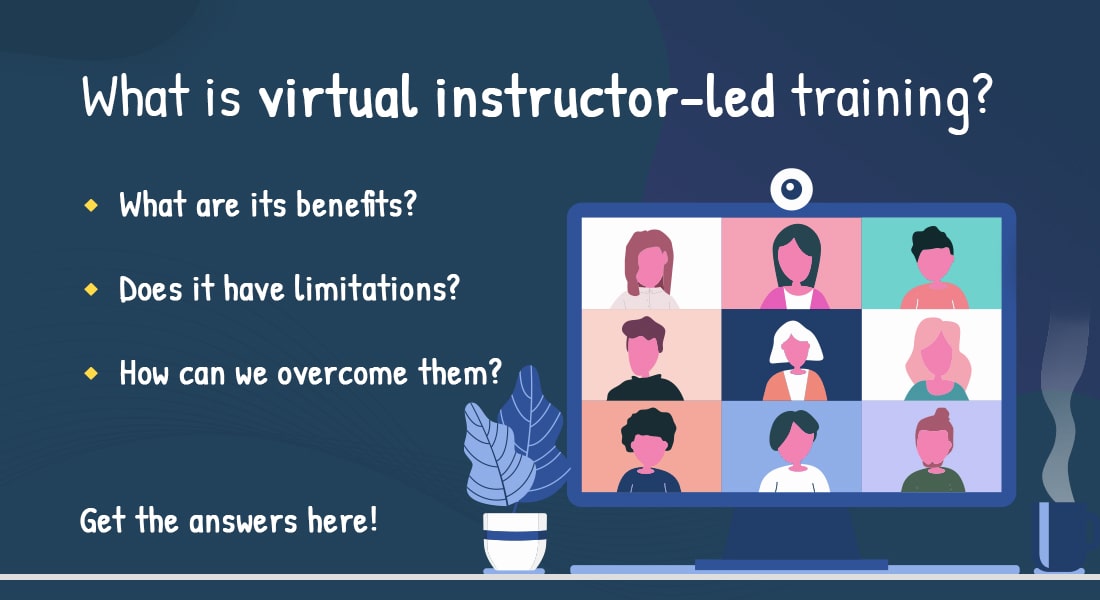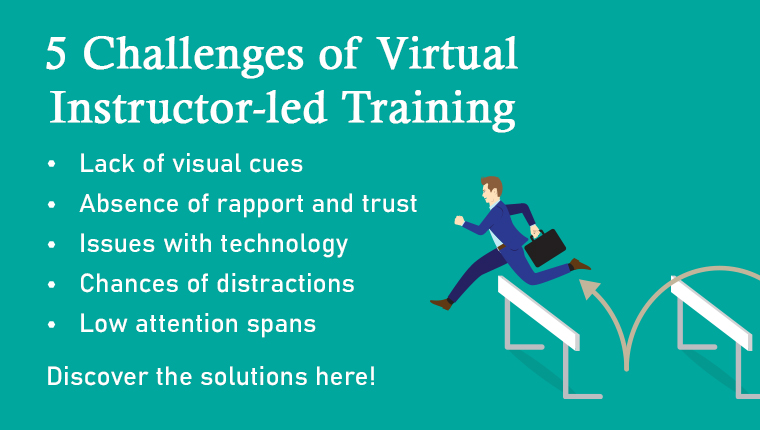The Top 5 Common Pitfalls of VILT and How to Avoid Them
VILT has opened a whole new world for corporate training. The success of this innovative, online approach to training hinges on L&D teams prevailing over its shortcomings. In this blog, we discuss the drawbacks of VILT (virtual instructor-led training), and how to overcome them.

Long before the worldwide COVID-19 pandemic began, we’ve been gradually moving toward greater digitalization. Much of our everyday life has gone online such as shopping, social networking, entertainment, and gaming, and their virtual platforms are catching on. Our work and learning schedules, though, stayed offline. Then came the social distancing rule when COVID-19 hit, making the transition online all the more urgent. That’s when VILT came to the rescue!
The demand for VILT (virtual instructor-led training) became extremely clear, resulting in a paradigm shift in how we see and conduct online training. And an increasing number of businesses are attempting VILT to keep their training programs afloat!
Now that you know the significance of the rise of VILT in the modern age, it’s time to understand its value and importance. But before that, you must first understand what makes up VILT.
What are the Common Mistakes to avoid when implementing VILT?
Here are the top 5 common pitfalls of VILT:
- Pitfall 1: Lack of Rapport and Trust
- Pitfall 2: Technological Difficulties
- Pitfall 3: The Challenge of Reduced Attention Spans
- Pitfall 4: Frequent Distractions and Disturbances
- Pitfall 5: Failure to Conduct Assessments or Collect Feedback
What is VILT?
VILT is a video-based, synchronous style of training that can be viewed online. They’re interactive sessions where an instructor and a learner interact in real time using video conferencing solutions like Google Meet, Zoom, and Microsoft Teams, regardless of their physical location or time zone. Instructors can create and execute collaborative training using tools such as PowerPoint slides, videos, polls, digital exercises, and conversations.
VILT enables learners, such as interns, workers, and C-suit executives to communicate with their instructors, such as managers, leaders, third-party experts, and coaches through a virtual video-conferencing platform. VILT is essentially the online version of instructor-led classroom training.
Let’s look at the role that VILT plays in corporate training.
Where Does VILT Fit in Corporate Online Training?
Virtual Instructor-led Training:
- Allows for direct communication between the instructor and the learner
- Enables learners and instructors to take part in sessions regardless of their location
- Allows for interactive sessions, whether in groups or one-on-one
- Facilitates the impartation of complicated concepts because of the presence of an online instructor
VILT supplies all the benefits of traditional classroom training online. It allows organizations to avoid the logistical headaches of classroom training while at the same time saving money. VILT replicates the classroom environment.
The pitfalls of VILT are plain to see now that the coronavirus has compelled us to use this inventive online platform so extensively. But wait! Can we avoid these pitfalls? We certainly can! Let’s look at some of the most common challenges of VILT, as well as solutions for each, to help your learners improve their online training experiences.
Pitfalls of VILT and their Solutions
Pitfall 1: Lack of Rapport and Trust
In virtual classrooms, the lack of face-to-face interaction makes it harder to establish rapport and trust between the instructor and their learners. Establishing a relationship of trust enhances learners’ comfort levels associated with the learning environment. One of the most significant disadvantages of VILT is when the instructor can’t read their learners’ nonverbal cues – facial expressions, eye contact, and body language to determine if they are engaged in their session or not. The lack of reciprocal nonverbal cues impacts the learner’s perception of their instructor and the course.
Virtual training cannot match the power of human, face-to-face communication. When people regard the instructor as “the go-to person” for their issues and queries, they are more likely to successfully learn new information. Without creating this relationship of trust, instructors must go above and beyond to connect with their learners.
Solution: What can the instructor do to build rapport and gain their learners’ trust?
- Schedule time for introductions at the beginning of the meeting. You can employ intriguing icebreaker games. For example, you can share references from pop-culture and ask your learners to share their thoughts.
- You can ask your instructors and learners to share favorite pictures, their areas of expertise and hobbies and provide brief biographies.
- Before the VILT session starts, you can send emails to your learners to develop a relationship of mutual trust. For instance, you can find out what they like doing outside of work or what excites them about their job.
- Respond to your learners’ online communication as soon as possible. This builds a working rapport where learners gain confidence to approach their instructors when they need to sharpen their skills.
- Encourage learners to access emoticons in chat boxes during virtual sessions to express their appreciation or displeasure and get answers to questions or share their thoughts.
Explore eLearning trends to make courses learner-centric.
Pitfall 2: Technological Difficulties
Software application flaws, network connectivity challenges, and delays are examples of technical issues in a virtual instructor-led session. Just as interruptions are annoying while you’re watching a good movie, listening to popular music, or playing a beloved video game, learners can also disengage from their online course because of technical challenges. This results in worsened retention and recall.
Solution: What can the instructor do to minimize technological concerns?
- Before the session, always test the technology – internet connection, security settings, software and downloads.
- Acquire a thorough understanding of your training platforms. Learn how to use online collaboration tools throughout your sessions.
- Provide your organization’s IT crew access to train your instructors on how to use their software’s features effectively.
- Use the ‘Lobby View’ to set up the virtual classroom. Problems right at the start of a session might put off your learners.
- Have a contingency plan. Backup your audios and videos on your computer in case the embedded files in your presentation fail.
Pitfall 3: The Challenge of Reduced Attention Spans
Most learners have short attention spans, not because they dislike learning, but because they are excellent multitaskers. They may be prone to get bored or distracted easily during VILT.
Passively sitting in front of a computer without doing anything might lead to weariness. Learners might feel like they are viewing a dull film. Even if they don’t fall asleep at the conclusion of the session, they will undoubtedly lose out on shared knowledge.
Solution: Making learning fun!
- You need to break your sessions into smaller modules with frequent intervals.
- You must assess your learners’ engagement and comprehension and ask questions frequently.
- When you present your content in diverse formats such as audios, mind maps, infographics, and videos you’re able to break the monotony of the sessions and foster greater interest.
- You can use online polls to help your learners stay in sync.
- You can also encourage teamwork when you use breakout rooms and involve your learners through games, discussions, and quizzes.
Pitfall 4: Frequent Distractions and Disturbances
Nowadays, technology is both a blessing and a curse! It can help a lot, but not used responsibly, it can also be a source of distraction. Your employees are surrounded by everyday chores, restless pets, and children who make a lot of noise when they work from home.
As there’s no one to supervise your employees at their homes, they could become sidetracked by social media, video games, and internet streaming. This does not occur in the traditional classroom, where instructors monitor their learners in person and engage them in fun activities when they get bored.
Solution: What can the instructor do to reduce learners’ distractions?
- Establish ground rules straight away to make sure everyone is on the same page.
- Request your learners to turn off their cell phones.
- You need to make sure that you ask questions and plan online polls regularly.
- You can engage your learners when you use virtual breakrooms for small groups.
- You mustn’t be monotonous. You need to keep your learners engaged by modulating your voice.
- When you design an inspiring plan of action you can make certain your presentation runs smoothly.
Pitfall 5: Failure to Conduct Assessments or Collect feedback
For effective VILT, it is essential that you gather crucial data from your sessions’ participants. When you gather the data, it enables your instructor to determine their learners’ requirements, and customize their training.
Solution: What are the different audience evaluation formats?
- Pre-training Assessment – This ensures that learners have the knowledge they need to participate in the training session. It’s possible that a few participants may need to undertake a foundation course.
- Post-training Assessment – This verifies that learners have grasped the concepts and skills they need, and that they’ve met their learning goals.
- Participant Surveys – Facilitators can use participant surveys to learn about issues that learners experience during VILT sessions. They could have anything to do with training content, distribution, tools, and technology.
Parting Thoughts!
The COVID-19 pandemic has stalled businesses requiring everyone to work from home. In these times, virtual training has been a lifesaver. Despite these constraints, you can do a lot with VILT. VILT sessions can help you reinforce learning for later recall through your learners listening to sessions that you’ve recorded.
So, don’t let VILT’s limitations hold you back! Use these keys to make your training a success. Here’s a free eBook that can help you offer engaging virtual instructor-led training sessions. It includes suggestions, resources, and solutions to help you create motivating and energizing online courses.





